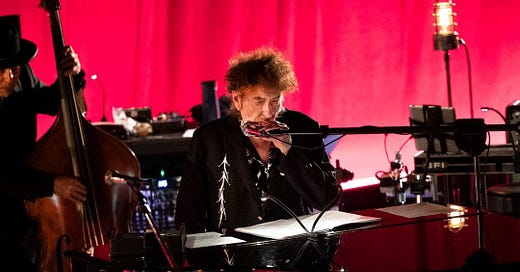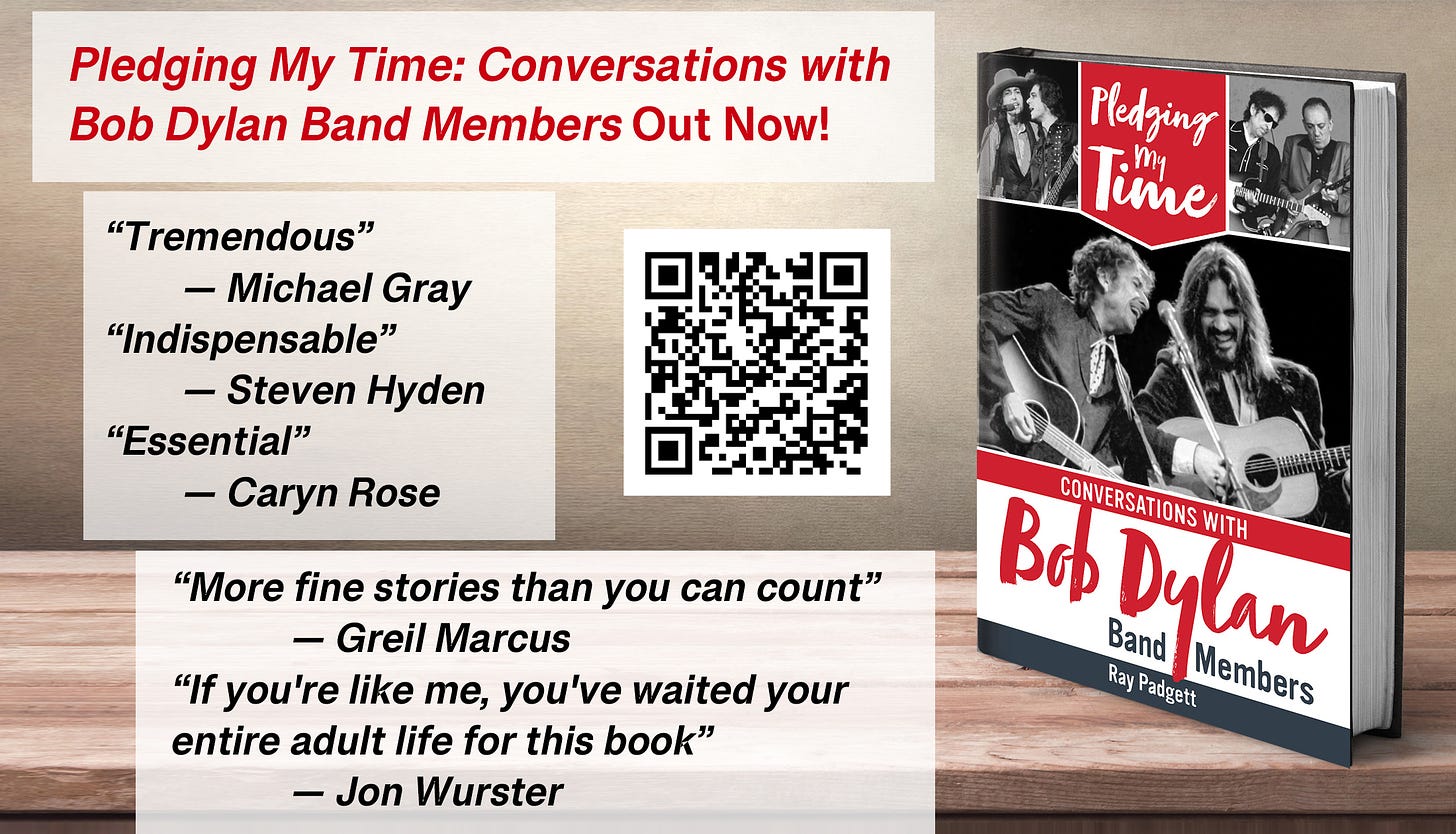Today’s tour report comes from Jack Walters, who writes in about last night’s Bob Dylan show (the first of two) in Lyon, France.
Jack’s new book Bruce Springsteen: Song by Song just came out last month. Maybe when Dylan takes a break from the Grateful Dead covers—“West LA Fadeaway” in Lyon last night—he’ll try some “Spirit in the Night” or “The River.” Though, Bob being Bob, he’d probably lead with “Queen of the Supermarket.”
Here’s Jack on a cinematic show in Lyon:
Once home of the Auguste and Louis Lumière, aka the Lumière brothers, Lyon is regarded as the birthplace of cinema. Through their development of Cinematograph—an apparatus for recording, developing, and projecting motion pictures—they created some of the earliest films. On 28 December 1895, in Paris, the brothers put on their first public screening for paying customers, which is generally considered as the dawn of cinema. The influence of cinema on Dylan is an integral part of his story; it is even in his blood. Dylan’s maternal great-grandfather, Benjamin Edelstein, ran a host of movie theatres, after arriving in America in 1902 from Lithuania with his wife, Lybba. A few generations later, Dylan’s uncles would operate Lybba Theater in Hibbing (named, of course, after Lybba Edelstein), where a teenage Dylan watched Rebel Without a Cause. Soon afterwards, he bought a red jacket in homage to Jim Stark—James Dean’s anti-hero character in the film—who famously wore one.
Dylan has also been influenced by a wide range of European directors and their films: Marcel Carné’s Children of Paradise (1945)—referenced in “I Contain Multitudes” as in the line “I live on the boulevard of crime”; François Truffaut’s Shoot the Piano Player (1960); Federico Fellini’s La Strada (1954), La Dolce Vita (1960), and 8½ (1963). Yet, in The Philosophy of Modern Song, Dylan wrote: “Likewise, Fellini, Kurosawa, and their counterparts around the world have made some terrific movies but we all know where the film industry got its first lap on the ass and drew its initial breath. People keep talking about making America great again. Maybe they should start with the movies.”
Lyon’s L’Amphithéâtre is a fitting place to see Dylan, whose shows are filled with high drama in the most subtle of ways. As the house lights dim—blanketing the stage in almost complete darkness—the crowd cheer over a Beethoven piece; ignoring one genius for another. Roll over Beethoven, or so the song goes. Although barely perceptible, Dylan and band not so much walk onto the stage as magically appear from out of nowhere: figures that seem insubstantial, almost unreal, phantom-like—and, who, collectively, appear weightless, as if borne by the music that is about to commence. What seems like a cacophony of dissonant chords at first transitions into “Watching the River Flow.” Over the somewhat jump blues rhythm, Dylan vacillates between the contentment of whiling away time beside the river and longing to be back in the city; the mixed feelings expressed within the jagged melody, especially with his stomping piano fills. And like a river, Dylan and the band will be coursing through the city and on to the next—yet not before a second night here, in Lyon, tonight.
Although played at a slower tempo, “Most Likely You Go Your Way and I’ll Go Mine” remains bitterly caustic, a valedictory like no other—and when the bowing of the double bass occurs in the bridge, Dylan produces not one but two glissando, with great fluidity. The present, the future, and past converge into one for “I Contain Multitudes,” as Dylan draws out the word: “contain”, creating a chasm between the two syllables.
There is a greater amount of vigour in the playing now compared to last fall’s shows. A meaty guitar riff by Bob Britt begins “False Prophet,” which finds Dylan playfully delivering his lines as in repeating “somebody’s” twice for dramatic effect. The unending cycle of the creative process is articulated best in “When I Paint My Masterpiece,” in which Dylan reaches a beautiful vocal crescendo on “I feel like my cup is running over.” And at the end, Dylan and Donnie Herron lock in; their piano and fiddle interweave, trading country licks as if on stage at the Grand Ole Opry. While Dylan is ensconced behind a baby grand piano, the band encircle him and follow his every move: from his staccato lines to R&B comping through to his malleable vocal phrasing; producing entire lines as if they were single words, while others times elongating words to the point that they seem like complete sentences, not to mention singing behind, ahead, or, on the beat.
One of the highlight of this entire Rough and Rowdy Ways Tour has been “Black Rider.” Tonight, again, it is spectral and ethereal; the tale of death has never sounded so seductively poignant. The new arrangement of “My Own Version of You” from this Euro leg is less urgent, somewhat insouciant; Jerry Pentecost, who, throughout the concert showcases his drumming prowess, supplies a steady backbeat, in addition to dueling jazz-inflected electric guitars and piano flourishes.
Dylan seemed to be in jovial mood: smiling to band members and laughed on two separate occasions during “I’ll Be Your Baby Tonight.” When introducing the band, he said how it isn’t easy to play these songs, but said that the band are playing well, don’t you think? A question that didn’t need to be answered.
On “I’ve Made Up My Mind to Give Myself to You,” Dylan tenderly caresses the words and stretches the chorus line that seems to never end; it is difficult not to infer that this is about him and the audience. One of the biggest responses from the crowd is for the cover of Grateful Dead’s “West L.A. Fadeaway.” With a swaggering coolness, Dylan delivers, and doubles down on the chorus. With a walking bassline, “Goodbye Jimmy Reed” has never sounded so sensual. In the end, Dylan concludes the show with “Every Grain of Sand” to come full circle with “Watching the River Flow,” where the point of both songs, or, at least, in the context of the show is the finiteness of life, as exemplified by the imagery of nature. No harmonica is needed, as the words, the imagery, the voice, and instrumentation are enough. Then Dylan and band take centre stage and line up before darkness envelops and they disappear into the night. It is as if it has been a figment of the imagination, or “maybe you’re hallucinating, you might think you’ve seen a ghost.” In any case, that’s it. Life flows on.
Thanks Jack! Check out his Bruce book on Amazon.
Hey, you know who ELSE had a book recently come out…?
Bunch of places to buy it—in hardcover, paperback, or ebook—here. Last day to get 15% off the hardcover!




